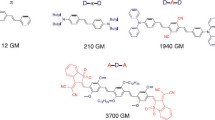Abstract
The β and γ nonlinear optical coefficients of substituted oligoacenes (1–10 rings) with the donors (D) groups –CH3, –CH2CH3, –CH2CH2CH3, –CH2CH2CH2CH3, –C(CH3)3, –CH3CHN(CH3)2, –N(CH3)2, –OCH3, –OCH2CH3, –OCH2CH2CH3, –OCH2CH2CH2CH3, –OC(CH3)3, and –OCHCH3N(CH3)2 and the acceptor (R) group –CHC(CN)2 is calculated by the AM1/TDHF method. A partial least squares regression analysis of electronic and structural parameters is performed to investigate their correlation with β and γ hyperpolarizabilities. It is found that the dipole moment, the HOMO–LUMO energy gap, the ionization potential, the number of π-electrons, and the number of rings in the bridge are parameters that significantly affect β and γ magnitudes. The dipole moment and the number of π-electrons are positively correlated with β values, while the HOMO–LUMO energy gap and the ionization potential are negatively correlated. Calculations indicate that the hyperpolarizabilities increase with the number of rings in the bridge and that the dimethylamine/dicyanoethenyl pair leads to the highest hyperpolarizabilities values. Optimization of β and γ is obtained through several substitution patterns of the oligoacenes. The present methodology shows that more extended systems containing two D/R pairs have high values of β and γ coefficients, which indicates that these systems can be employed in manufacturing nonlinear optics devices.












Similar content being viewed by others
Abbreviations
- β:
-
First hyperpolarizability
- γ:
-
Second hyperpolarizability
- HOMO:
-
Highest occupied molecular orbital
- LUMO:
-
Lowest unoccupied molecular orbital
- ΔHL :
-
HOMO–LUMO energy gap
- μ:
-
Ground state dipole moment
- IP:
-
Ionization potential
- AM1:
-
Austin Model 1
- TDHF:
-
Time-dependent Hartree–Fock
References
Kanis DR, Ratner MA, Marks TJ (1994) Chem Rev 94:195
Facchetti A, Annoni E, Beverina L, Morone M, Zhu P, Marks TJ, Pagani GA (2004) Nat Mater 3:910
Machado AE, Gama AAS (2003) J Mol Struct (THEOCHEM) 21:620
Brédas JL, Adant C, Tackx P, Persoons A (1994) Chem Rev 94:243
Stegeman GI, Wright EM (1990) Opt Quant Electron 22:95
Stegeman GI, Wright EM (1990) Org Mater Nonlinear Optics II(1991):311
Shen YR (1984) The principles of nonlinear optics. Wiley, New York
Resende SM (1996) A Física de Materiais e Dispositivos Eletrônicos, Ed. of UFPE: Recife
Nalwa HS (2001) Handbook of advanced electronic and photonic materials and devices, V. 9: nonlinear optical materials. Academic Press, San Diego
Castellano O, Giffard M, Chrysos M, Sylla M, Nguyen-Phu X, Hinchliffe A, Soscun H (2005) J Mol Structure (THEOCHEM) 716:1
Norman P, Jonsson D, Ågren H, Dahle P, Ruud K, Helgaker T, Koch H (1996) Chem Phys Lett 1:253
Reis H, Papadopoulos MG, Calaminici P, Jug K, Köster AM (2000) Chem Phys 359:261
Santos MC (2006) Phys Rev B 74:045426
Halik M et al (2004) Nature 431:963
Bendikov M, Wudl F, Perepichka DF (2004) Chem Rev 104:4891
Zhang L, Taguchi D, Masada H, Manaka T, Iwamoto M (2012) Jpn J Appl Phys 51:02BK08
The Unscrambler 9.6. CAMO Software AS, Nedre Volgate 8, N-0158 OSLO, Norway
Machado AE, Neto BB, Gama AAS (2004) J Comp Meth Sci Eng 4:267
Costa MBS, Machado AE, Neto BB (2007) Comp Lett 3:267
Machado AE, Gama AAS, Neto BB (2011) Chem Phys 388:19
Karna SP, Dupuis M (1991) J Comp Chem 12:487
Sekino H, Bartlett RJ (1986) J Chem Phys 85:976
Stewart JJP (1999) MOPAC2000 Manual. Fujitsu Limited, Tokyo
Moura GLC, Simas AM, Miller J (1996) Chem Phys Lett 257:639
Machado AE (2001) Hiperpolarizabilidades semi-empíricas de sistemas orgânicos doador-receptor. PhD Thesis, Universidade Federal de Pernambuco, Brazil
Machado AE, da Gama AAS (2005) Intern J Quantum Chem 103:625
Machado AE, da Gama AAS (2008) J Braz Chem Soc 19:1381
Brennand RA, Machado AE (2010) J Comput Meth Sci Eng 10:205
Lu Y, Lee S (1992) Int J Quantum Chem 44:773
Lee S, Yang K, Sheu J, Lu Y (1995) Int J Quantum Chem 29:509
Acknowledgements
The authors acknowledge the Conselho Nacional de Desenvolvimento Científico e Tecnológico (CNPq), Brazil, for their financial support.
Author information
Authors and Affiliations
Corresponding author
Rights and permissions
About this article
Cite this article
Costa, M.B.S., de A. Machado, A.E. & Pavão, A.C. Theoretical assessment of the nonlinear optical properties of substituted oligoacenes. J Mater Sci 48, 192–200 (2013). https://doi.org/10.1007/s10853-012-6728-0
Received:
Accepted:
Published:
Issue Date:
DOI: https://doi.org/10.1007/s10853-012-6728-0




